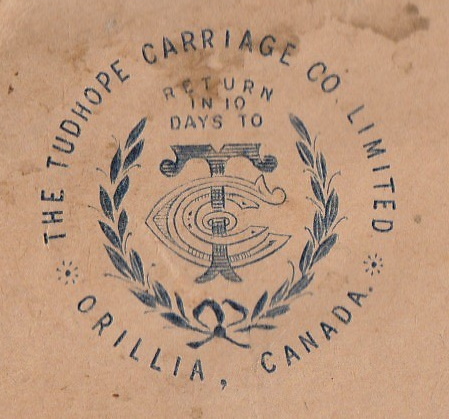In August 2022, a genealogist got in touch with Orillia Heritage Centre and offered to share some interesting artifacts he discovered while researching his wife’s family history.
While researching his wife's family tree, Terry Young of Hagersville, Ontario came across some documents related to the Tudhope Carriage Co. in the personal records of her grandfather, Joseph Peart.
Joseph Barclay Turnbull Peart was born in Caledonia, Ontario in 1888.
At the age of 24, after studying at a business college, he moved to Orillia and started working for the Tudhope Carriage Co. While in Orillia, he met and married Delta Amey. The couple purchased a tract of land in York and moved back to Haldimand County in 1914.
During his employment at Tudhope Carriage Co., Peart appears to have been engaged in a “cost-accounting” role. After he died in 1974, several documents were discovered containing cost worksheets for various jobs and materials produced at Tudhope. It is unclear why these documents were amongst his personal effects, but they provide an interesting glimpse into how Tudhope Carriage Co accounted for the costs of their operations at the time.
The set of documents acquired by OHC is organized into 32 “document sets” - some containing multiple pages. They have been scanned and published for public access - along with an index providing a brief catalog of contents.
Most of the documents are dated and the dates range from September 1912 to June 1914. During this time, Tudhope was operating both the Tuhdope Carriage Co and the Tudhope Automobile Co out of the same building at West and Colborne (now Orillia City Hall). Peart worked for Tudhope Carriage Co., but a number of these documents show how the Carriage Co. was involved in the production of automobiles. For example, doc-set #20 shows a costing work-up done in Sep-1912 for the production of 100 aluminum bodies with paint and trim for the 1913 model 6-48 (Tudhope’s last automobile model). The chassis and power train would have been produced by Tudhope Automobile Co., but the body, wheels, interiors and tire mounts were done by the Carriage Co.
It can be interesting to contemplate “business operations” in this era. Pre-computers, everything was paper-based using typewriters. Costing for standard components and standard job completions were worked out in lots of either 50 or 100 units and included various overhead apportionments (e.g., 10%, 25%). Common materials produced in-house were costed by batch (e.g. doc-set #14 “batch body primer” or doc-set #19 “wheel primer”). We can also learn something about how the division of tasks was implemented at Tudhope with documents referencing: the paint shop, the smith shop, the mill & woodshop, the trim shop, and the mounting room.
Click here to view the index.

